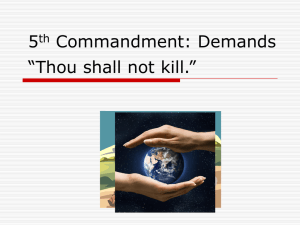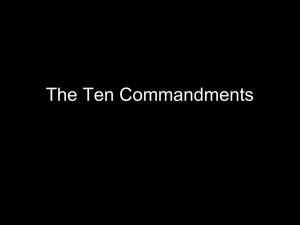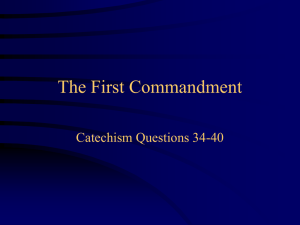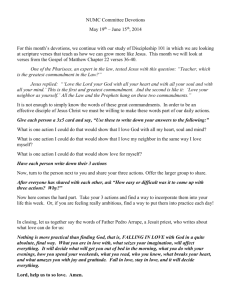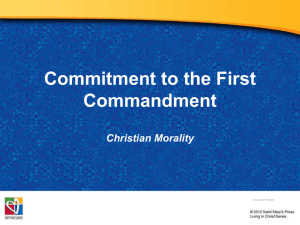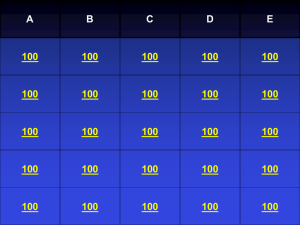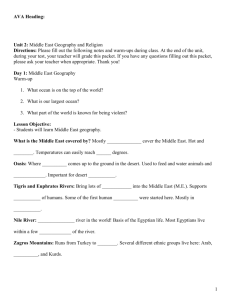5717,"7 commandments",12,15,"2000-02-22 00:00:00",480,http://www.123helpme.com/view.asp?id=15455,6,22500000,"2016-02-29 02:16:39"
advertisement
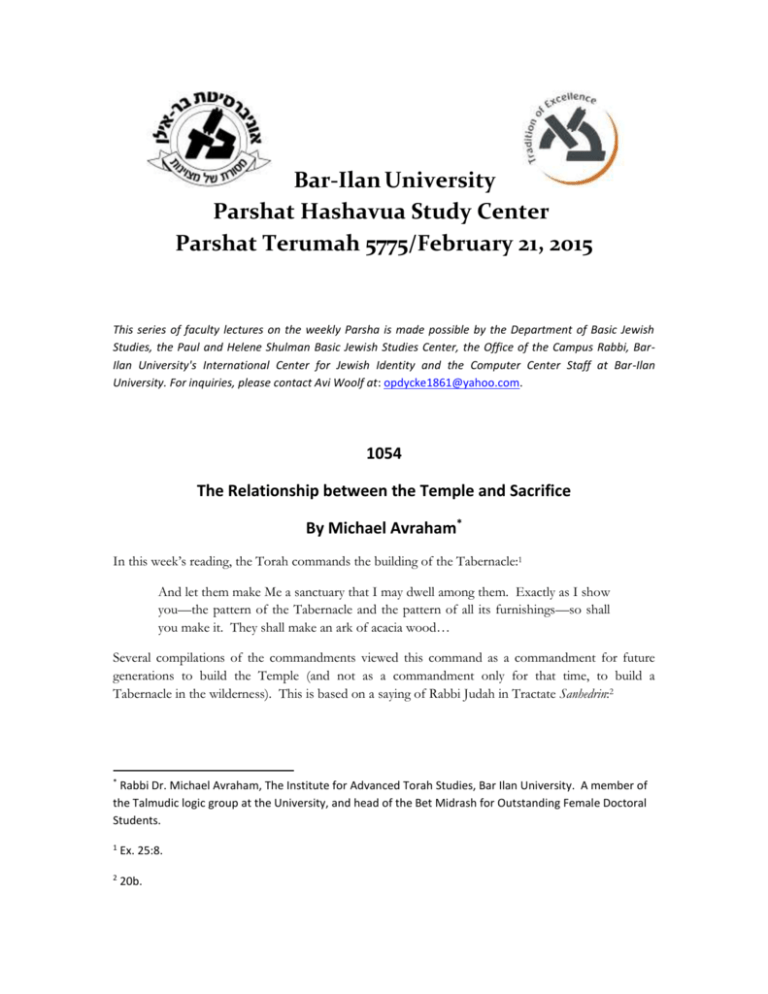
Bar-Ilan University Parshat Hashavua Study Center Parshat Terumah 5775/February 21, 2015 This series of faculty lectures on the weekly Parsha is made possible by the Department of Basic Jewish Studies, the Paul and Helene Shulman Basic Jewish Studies Center, the Office of the Campus Rabbi, BarIlan University's International Center for Jewish Identity and the Computer Center Staff at Bar-Ilan University. For inquiries, please contact Avi Woolf at: opdycke1861@yahoo.com. 1054 The Relationship between the Temple and Sacrifice By Michael Avraham* In this week’s reading, the Torah commands the building of the Tabernacle:1 And let them make Me a sanctuary that I may dwell among them. Exactly as I show you—the pattern of the Tabernacle and the pattern of all its furnishings—so shall you make it. They shall make an ark of acacia wood… Several compilations of the commandments viewed this command as a commandment for future generations to build the Temple (and not as a commandment only for that time, to build a Tabernacle in the wilderness). This is based on a saying of Rabbi Judah in Tractate Sanhedrin:2 * Rabbi Dr. Michael Avraham, The Institute for Advanced Torah Studies, Bar Ilan University. A member of the Talmudic logic group at the University, and head of the Bet Midrash for Outstanding Female Doctoral Students. 1 Ex. 25:8. 2 20b. And thus Rabbi Judah said: Three commandments were given to Israel when they entered the land: [i] to appoint a king, [ii] to cut off the seed of Amalek, and [iii] to build themselves the chosen house [=Temple]. Maimonides and those who carried on his tradition ascribed source of this commandment to the verse at hand:3 Positive commandment 20: We are commanded to build a Sanctuary to serve [G-d]. In it we offer sacrifices, burn the eternal flame, offer our prayers, and congregate for the festivals each year, as will be explained. The source of this commandment is the Almighty’s statement, “Let them make Me a sanctuary.” The Sifri says, “The Jewish people were commanded to fulfill three commandments upon entering the Land: to appoint themselves a king, to build themselves a Sanctuary, and to wipe out Amalek. This wording shows that building the Sanctuary is counted as a distinct commandment. We have already explained that this general term [Sanctuary] includes many parts. The lampstand, the table, the altar and the like are all parts of the Sanctuary, and together are called the Sanctuary, even though the Torah details the requirements for each individual element. Maimonides asserts that building the various furnishings of the Temple is not to be reckoned as a distinct and separate commandment, since these are subsumed in the commandment of building the Temple itself. He details this further in Root 12, in which he stresses that component parts of a task from among the tasks we are commanded - such as the stages of sacrificing each offering - should not be count separately. He begins his remarks there by asserting, further, that one should not count the furnishings of the Temple as separate commandments, and proves his point using verses in this week’s reading: The twelfth root is that one should not enumerate separately the parts of a task belonging to a task we have been commanded, counting each part in its own right. It is well known that at times we are commanded regarding a certain action, and then Scripture sets about explicating the nature of that action, explaining the appellation and the details that comprise it. This being so, it is not proper to count each command that appears in that explication of the commandment as a distinct commandment. For example, as it is said: Let them make Me a sanctuary, this being one of the general list of positive commandments, namely, that we should prepare a House to which we can come and celebrate, and where the sacrifices can be offered, and where we can congregate on the Festivals. Then Scripture sets about describing its parts and how they are to be made. Each “you shall make” should not be counted as a commandment in its own right. The sacrifices listed in Leviticus follow just the same principle: the single commandment is the general task described for each of the various types of offerings. Thus Maimonides interprets the verses that follow in this week’s reading as detailing the general commandment to build a Sanctuary.4 3 Maimonides, Sefer ha-Mitzvot, positive commandment 20. Also cf. Sefer ha-Hinukh, commandment 95. Nahmanides, in his glosses to Sefer ha-Mitzvot, took issue with Maimonides on this point. In Positive Commandment 33 Maimonides enumerated the commandment that the priests wear priestly vestments when ministering the sacred service, whereas Nahmanides cites the approach taken by Halakhot Gedolot, that his not be counted as a separate commandment since, according to him, wearing the vestments is preparation for ministering and not a commandment in its own right. Nahmanides goes on to say: It has already been explained (Root 12) that component parts of a commandment are not counted. Therefore, we do not count making the table, the lampstand, and the altar as commandments, since we were commanded to place bread before the Lord permanently, and we were commanded how to perform this service, namely to place it on the table as described and arranged there appropriately. Likewise, the Lord commanded us to kindle lights before Him, arranging the lighting in a lampstand made of a specified quantity of gold, and similarly with the sacral vestments. In my opinion, the argument given by the Rabbi (in commandment 20), that they are part of the Sanctuary, is not valid, since the furnishings are not part of the House. Rather, these are two separate commandments that do not forestall one another, insofar as sacrifices could be offered in the House even if these furnishings were not in it. Nahmanides ostensibly repeats Maimonides’ words here, according to which the furnishings are not to be counted as a separate commandment. A closer look, however, reveals that he has quite something else in mind. In his view, although making the furnishings is not to be considered a separate commandment, the reason is not that they are subsumed by the commandment of building the Sanctuary, rather that they are included in the commandment of the sacred service itself. Building the table is part of the commandment of the showbread that is to be put on it. According to his approach, making the furnishings is in preparation for fulfilling a commandment, i.e., preparing the necessary means for performing the commandment itself. Therefore he adds at the end of the paragraph that he does not approve of Maimonides claim that the furnishings are an intrinsic part of the Sanctuary. In his view, the furnishings are not part of the House, rather the House and the furnishings comprise two separate commandments that are not interdependent on each other.5 4 Minhat Hinukh, commandment 95.8, deals with the question whether building the Sanctuary furnishings is part of the commandment of building the Temple or part of the commandment of the worship itself. The conclusion there tends to follow Maimonides, asserting it is part of the commandment of the worship. This clearly is Nahmanides’ view, but Maimonides apparently was not of like opinion (as he spells out in Positive Commandment 20 and in Root 12). We note further that Ha-Hinukh also says that building the furnishings is part of the commandment to build the Sanctuary. 5 Root 11 explains that according to Maimonides (and Nahmanides, as well, concurs in part) there are pairs of commandments that do not forestall one another but nevertheless are counted as a single commandment (as in the blue and white in the tzitzit). See my article, “Mitzvot ve-Helkei Mitzvot--`Al Mahutam ha-Philosophit shel Musagim ba-Halakhah,” Akdamut 21, Elul (Aug.) 2008, p. 160. This difference of opinion seems to stand on differing perceptions of the function of the Sanctuary. Maimonides begins his remarks on Positive Commandment 20 in the following terms: “We were commanded to build a House of Worship, in which the sacrifices are offered and a perpetual fire burned.”6 In other words, according to his approach, the aim of the Sanctuary is to serve as a place of worship. Given such a perception, it is patently clear that the furnishings of the Sanctuary are part and parcel of the building itself, for the entire purpose of the building is to use its furnishings. The beginning of the passage from Root 12, cited above, is also quite similar. Nahmanides, in his commentary on this week’s reading, however, writes:7 …and He said further: and ye shall be unto Me a kingdom of priests, and a holy nation (Ex. 19:6). They are now holy, in that they are worthy that there be amongst them a Sanctuary through which He makes His Divine Glory dwell among them. Therefore He first commanded concerning the Tabernacle, so that He have amongst them a house dedicated to His name, from where He would speak with Moses and command the children of Israel. Thus the main purpose of the Tabernacle was to contain a place in which the Divine Glory rests, this being the ark, just as He said, And there will I meet with thee, and I will speak with thee from above the ark-cover (Ex. 25:22). Therefore He first gave the commandment about the ark and the ark-cover, for they are first in importance…The secret of the Tabernacle is that the Glory which abode upon Mount Sinai [openly] should abide upon it in a concealed manner. For just as it is said there, And the glory of the Eternal abode upon Mount Sinai (Ex. 24:16), and it is further written, Behold, the Eternal our G-d hath shown us His glory and His greatness (Deut. 5:21), so it is written of the Tabernacle, and the glory of the Eternal filled the Tabernacle (Ex. 40:34). Twice is this verse, and the glory of the Eternal filled the Tabernacle (ibid., also v.35) mentioned in connection with the Tabernacle, to correspond with His glory and His greatness. Thus Israel always had with them in the Tabernacle the Glory which appeared to them on Mount Sinai…And Scripture so states: where I will meet with you, to speak there unto thee; and it shall be sanctified by My glory (Ex. 29:42), for there [in the Tabernalce] will be the appointed place for the Divine utterance, and it will be sanctified by My glory (Ex. 29:43). From these remarks clearly the purpose of the Tabernacle and the Temple was to provide a place for the Divine Presence to dwell among Israel on earth, and not, as Maimonides thought, to serve as a “place of worship.” According to Maimonides, the essence of the Sanctuary lay in the altar, while according to Nahmanides it was in the ark (which itself is not used for the worship or for any other commandment). Sacrificing was just one of the functions that took place in the Sanctuary and perhaps contributed as well to its being a place for the Divine Presence to reside. Now it becomes perfectly clear why Nahmanides was of the opinion that the furnishings were not part of the House. The House was intended as a place for the Divine Presence, and the furnishings were for worship; both of these were commandments that did not depend one on the other (for 6 7 Maimonides, Sefer ha-Mitzvot, Commandment 20. Nahmanides on Ex. 25:2, Ramban Commentary on the Torah, Exodus, trans. and annotated by Rabbi Dr. Charles be Chavel, Shilo Publishing House, New York, 1973, pp. 434-436. sacrifices are offered even without there being a House).8 Maimonides, on the other hand, saw the furnishings as part of the House, since in his opinion the House in its entirety was intended for sacrificial worship. Of course, we could go further and ask what were the foundations of this difference of opinion; why did Maimonides view the Sanctuary as a serving the sacrificial worship, while Nahmanides viewed it as a means of providing for the Divine Presence? Here we can only hypothesize, without being able to substantiate our theory. Perhaps, for Maimonides, the man of Halakhah, there was no significance to the Divine Presence as a metaphysical being. In his eyes, the Halakhah dealt only with practical obligations (commandments). The late Yeshayahu Leibowitz, when discussing the sanctity of the Land of Israel, used to cite the Mishnah:9 “Wherein lies its sanctity, that the omer and first fruits and the two loaves be brought from it, but not be brought from all the other lands of the earth?” He saw the sanctity of the land in terms of the commandments through which that sanctity is expressed. So, too, with the Temple, he considered that its sanctity pertained to the commandments performed therein.10 Nahmanides, however, more of a mystic, perceived metaphysical significance in the Temple and the land of Israel themselves, beyond their concomitant commandments. This, however, is only a hypothesis and requires its own investigation. Translated by Rachel Rowen 8 Babylonian Talmud, Zevahim 107b and parallel texts. 9 Kelim 1.6. 10 This was apparently why Maimonides did not include settling the land of Israel in his list of commandments. Many associate this with Root 4 (that inclusive commandments are not counted), but closer examination of Root 4 shows that this is a misunderstanding of Maimonides’ concept of “inclusive commandments” (I add here that the commandments of faith are listed under the first positive commandment, even though it is more inclusive). According to our proposal, not including settling the land of Israel in his list of commandments actually has to do with Root 10 (that actions done in preparation of fulfilling a commandment are not counted separately), since settling the land of Israel is a means to fulfilling the commandments that are dependent on the land itself.
